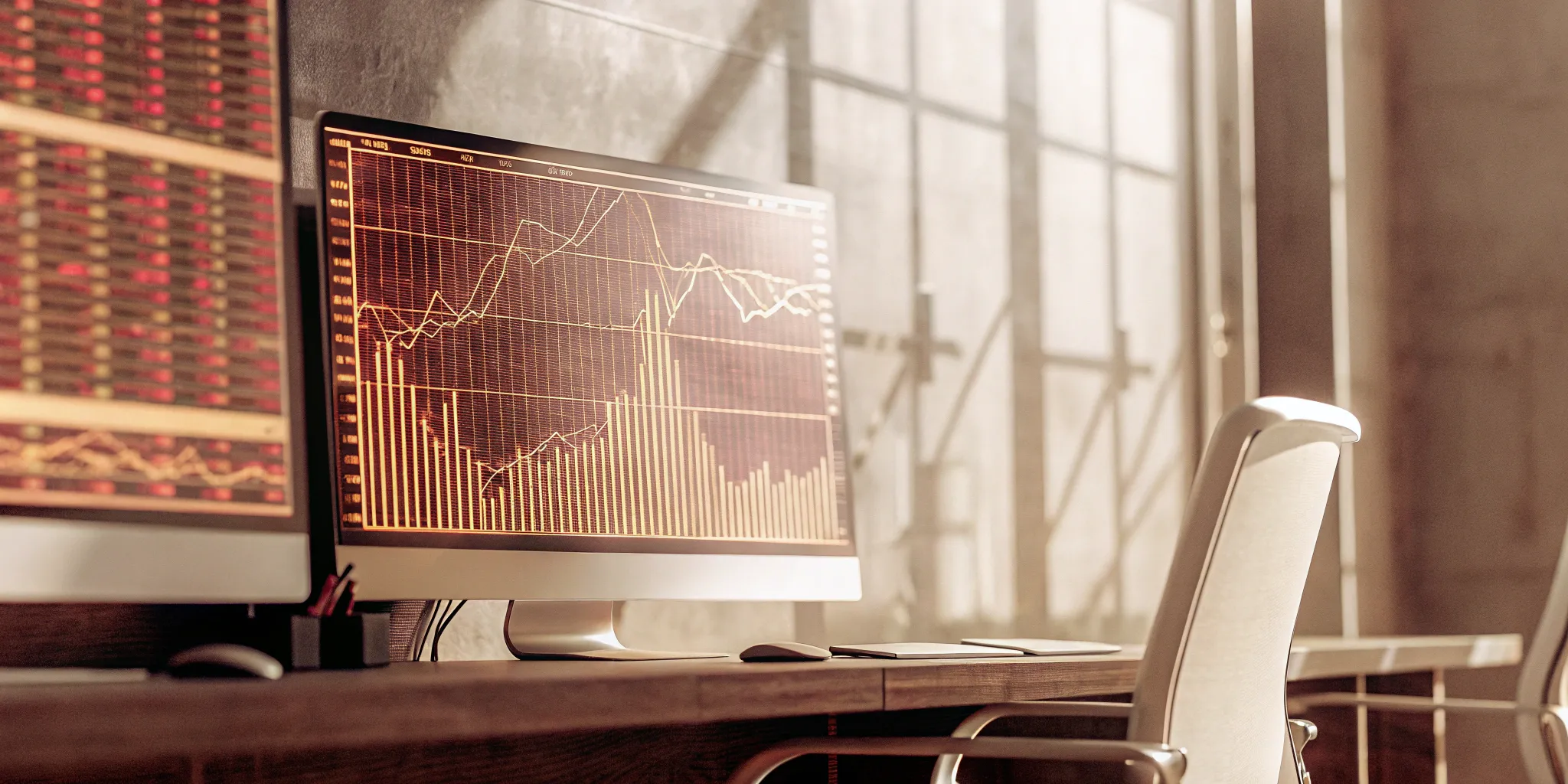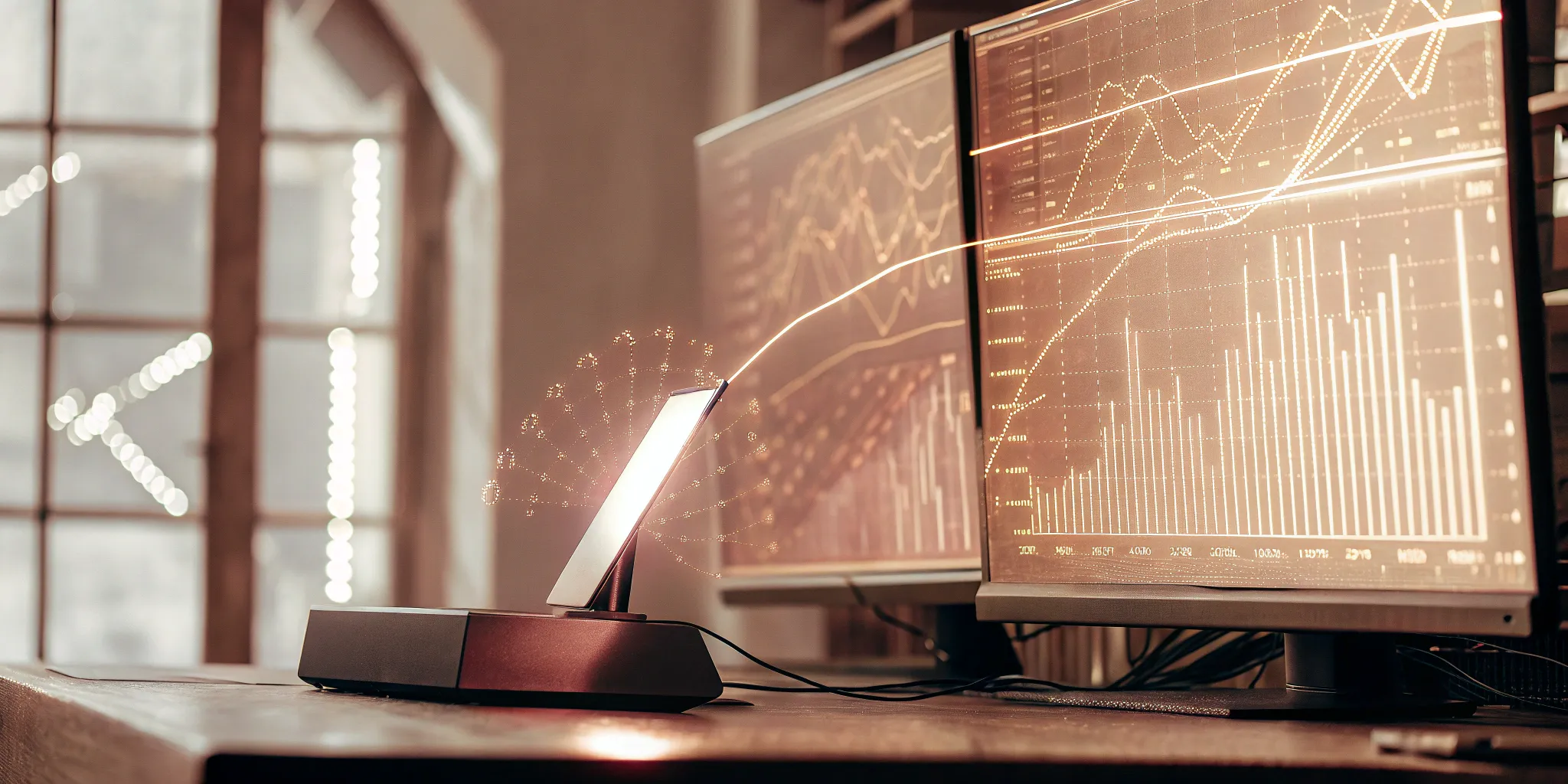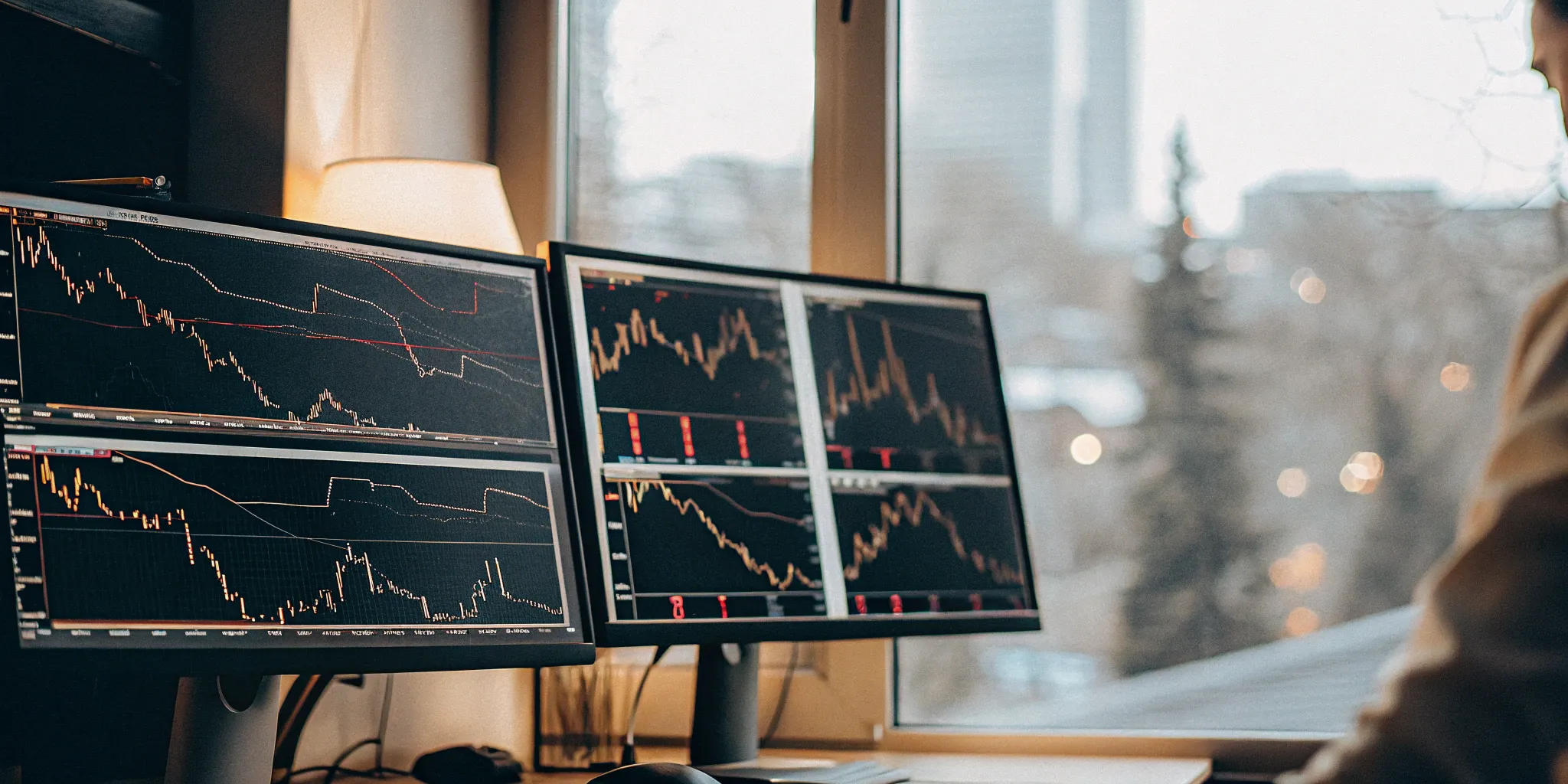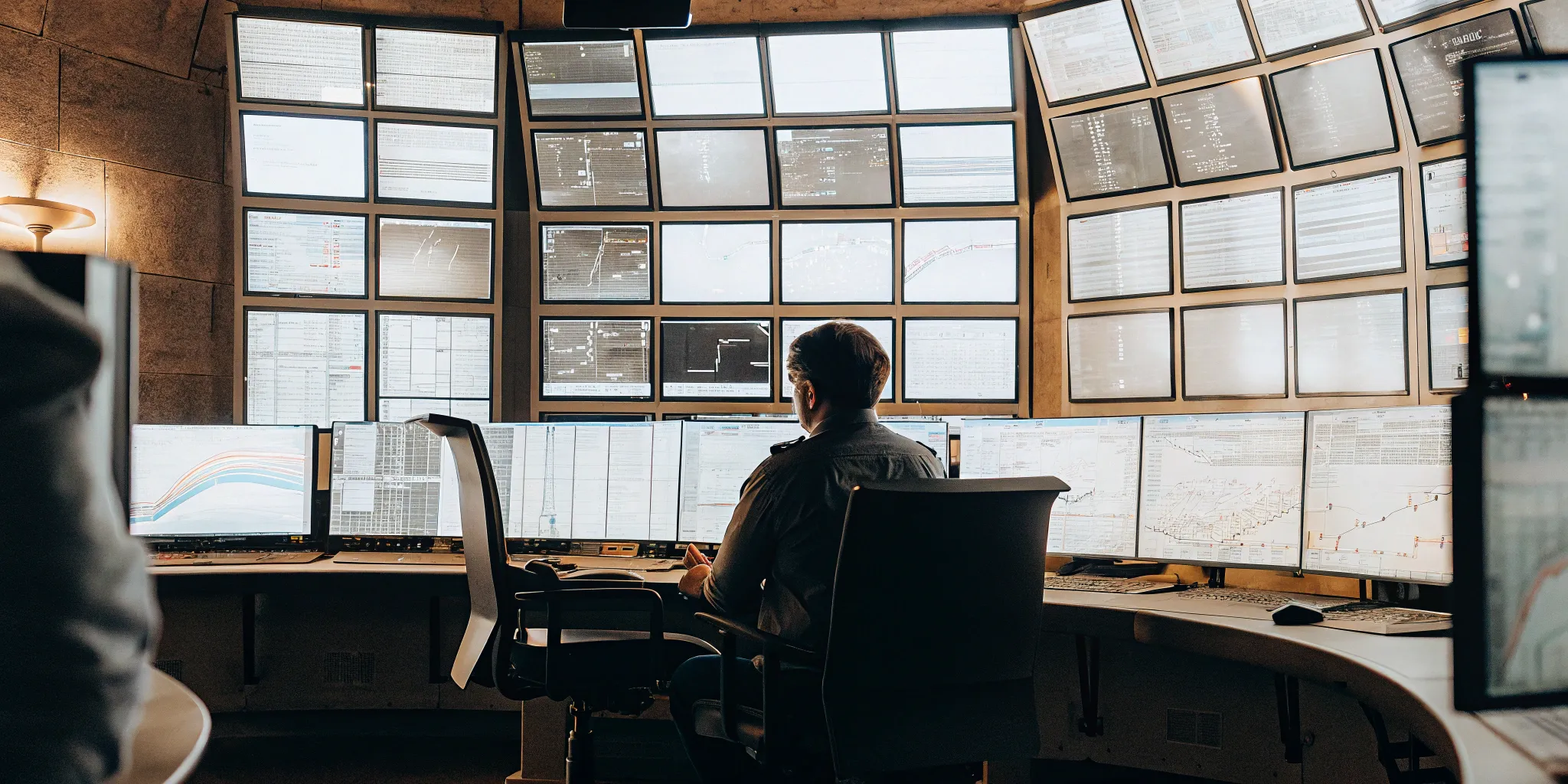For decades, the most powerful trading tools were reserved for large financial institutions and hedge funds with billion-dollar budgets. The average investor was left on the outside looking in. That era is over. Technology is leveling the playing field, and AI trading algorithms are leading the charge. These sophisticated systems give individual investors access to the kind of speed, analytical power, and disciplined execution that was once out of reach. This guide is about empowerment. We’ll explain how these tools function and how they can help you implement a data-driven strategy, giving you access to an institutional-grade approach to building your portfolio.
Key Takeaways
- Trade with logic, not emotion: The greatest advantage of AI is its ability to execute a strategy based on pure data, removing the costly mistakes that fear and greed often cause for human traders.
- Prioritize systems with built-in risk management: A powerful AI doesn’t just find opportunities; it actively protects your capital with dynamic tools that adapt to real-time market volatility.
- Verify performance to avoid empty promises: Instead of relying on marketing claims, look for a publicly verifiable track record. This transparency is the clearest indicator of a system’s real-world consistency and reliability.
What Exactly Is an AI Trading Algorithm?
Let’s break down what an AI trading algorithm really is, without the confusing tech-speak. At its core, an AI trading algorithm is a sophisticated computer program designed to analyze market data and execute trades automatically. Think of it as a highly disciplined, data-driven assistant that works around the clock. Instead of relying on gut feelings or manually staring at charts, these systems use complex math and logic to make decisions.
The goal is to remove human emotion—like fear and greed—from the trading process, which is often where investors make their biggest mistakes. These algorithms can process enormous amounts of information, from price movements to economic news, far faster than any person could. This allows them to spot potential opportunities and act on them in fractions of a second. For individual investors, this brings a level of speed and efficiency that was once only available to large financial institutions, creating a more level playing field.
The Brains Behind the Bot: How They’re Built
So, how does an AI trading bot learn to trade? It all starts with data—a massive amount of it. Developers feed the algorithm historical market data, allowing it to study past price movements, trading volumes, and economic indicators. By analyzing these past scenarios, the AI learns to identify patterns and correlations that often signal a potential market shift.
These advanced algorithms are built to find complex, non-linear connections that might not be obvious to the human eye. For example, FN Capital’s FAST AI was trained to find very specific, high-probability setups in the EUR/USD pair. It’s not just about following simple “if-then” rules; it’s about building a predictive model that can adapt as it processes new information, constantly refining its strategy based on what’s happening in the market right now.
From Punch Cards to Predictive Power: A Quick History
While using computers for trading has been around for decades, the introduction of true artificial intelligence is what has completely changed the landscape. Early algorithmic trading was more rigid and rule-based. Think of it as a basic calculator that could only perform the specific functions it was programmed to do. It was an improvement, but it lacked the ability to learn or adapt.
Modern AI is different. It’s more like a supercomputer that can teach itself. This shift is revolutionizing stock investing and forex trading by moving beyond the limits of human intuition. Instead of just following a static set of instructions, today’s AI can analyze new data in real time, learn from its own performance, and adjust its approach accordingly. This evolution from simple automation to intelligent adaptation is what makes AI trading such a powerful tool for modern investors.
How Does an AI Trading Algorithm Actually Trade?
It’s easy to imagine an AI trading bot as a mysterious black box that somehow prints money. The reality is a lot more methodical and, frankly, more interesting. At its core, an AI trading algorithm follows a disciplined, three-step process over and over: it finds a potential opportunity, analyzes it against its rules, and then acts on it with precision. Think of it as the most dedicated analyst you’ve ever met—one that never gets tired, never gets emotional, and can process millions of data points in the time it takes you to blink.
This process isn’t random; it’s highly structured. The algorithm is programmed to look for specific conditions in the market. For example, our FAST AI algorithm is designed with a laser focus on the EUR/USD currency pair. It doesn’t get distracted by chatter about stocks or other currencies. Instead, it dedicates all its processing power to understanding the unique behavior of that one market, allowing it to identify low-risk, high-probability setups. This cycle of finding, analyzing, and executing is what allows the AI to operate autonomously, making thousands of calculated decisions without a human needing to step in for every single trade.
Finding Patterns in Market Noise
The financial markets are incredibly noisy. There are price movements, news headlines, economic reports, and millions of transactions happening every second. For a human, trying to make sense of it all can be overwhelming. An AI algorithm’s first job is to cut through that chaos. It sifts through massive historical and real-time datasets to find meaningful patterns that are often invisible to the human eye. These aren’t simple “if this, then that” rules; the AI can uncover complex, non-linear relationships between different variables. By leveraging big data in investing, the algorithm identifies recurring setups that have historically led to a predictable outcome, giving it a statistical edge.
Making the Call: From Data to Decision
Once the algorithm spots a potential pattern, it doesn’t just blindly place a trade. The next step is a rigorous analysis where the opportunity is weighed against a strict set of rules and risk parameters. This is where the system’s core logic—its financial models—comes into play. The AI calculates the optimal trade size, determines where to place a stop-loss to limit potential downside, and sets a target for taking profits. At FN Capital, our DART (Dynamic Algorithmic Risk Tool) is constantly running these calculations. It ensures that every trade aligns with our risk management strategy, effectively answering the critical question: “Is the potential reward of this trade worth the risk?” Only if the answer is yes does the algorithm proceed.
Executing Trades and Watching the Market
With a valid trade signal confirmed and the risk parameters set, the final step is execution. The algorithm sends the trade order to the broker instantly. This speed is a major advantage, as it minimizes slippage and ensures the trade is entered at the desired price. But the AI’s job isn’t done. It continues to monitor the open position and the broader market in real time. If market conditions change, it can adjust the stop-loss to protect profits or exit the trade entirely based on its pre-programmed rules. This constant, unemotional supervision is a key part of quantitative trading and is what allows the system to manage positions efficiently from entry to exit.
Not All AI Is the Same: Common Trading Strategies
When you hear the term “AI trading,” it’s easy to picture a single, all-knowing robot making perfect trades. The reality is a lot more nuanced. “
Some algorithms are built on a strict set of “if-then” rules, while others are designed to read the internet’s mood by analyzing news and social media. More advanced systems use machine learning to find hidden patterns in data, constantly refining their own strategies. Then there’s the world of high-frequency trading, where the main goal is pure, unadulterated speed. Understanding these different approaches is key to seeing what’s really happening behind the scenes. At FN Capital, our FAST AI algorithm is a proprietary system engineered for a specific purpose: high-frequency execution with a sharp focus on risk management in the EUR/USD market.
Rule-Based Algorithmic Trading
This is one of the most foundational forms of automated trading. A rule-based system operates on a simple, strict set of predefined instructions. Think of it as a checklist: if a specific condition is met, the algorithm executes a trade. These rules are often based on common technical indicators, like “buy if the 50-day moving average crosses above the 200-day moving average.” It’s systematic, disciplined, and completely removes human emotion from the execution process. The main limitation is that it’s only as smart as the rules it’s given. It can’t adapt to new market dynamics on its own and will follow its programming, for better or worse, until a human reprograms it.
Trading on the News and Social Buzz
This strategy uses AI to gauge market sentiment by analyzing massive amounts of text-based data in real time. These algorithms scan news articles, financial reports, and even social media posts to understand the collective mood surrounding an asset. By using natural language processing (NLP), the AI can detect whether the tone is positive, negative, or neutral and execute trades based on shifts in public perception. For example, it might spot a positive earnings report seconds after it’s released and place a buy order before most human traders have even finished reading the headline. This approach turns unstructured information into actionable trading signals, capturing opportunities that arise from breaking news.
Self-Learning Systems: Machine & Deep Learning
Here’s where AI trading gets really interesting. Unlike rule-based systems, self-learning algorithms aren’t just following a static set of instructions. Instead, they use machine learning and deep learning to analyze historical market data, identify complex patterns, and adapt their strategies over time. These systems learn from every trade—both wins and losses—to constantly refine their decision-making process. They can uncover subtle correlations that a human analyst might miss entirely. This adaptive capability allows them to evolve with changing market conditions, making them incredibly powerful tools for developing sophisticated and dynamic trading models. It’s this ability to learn and improve that forms the core of many advanced AI systems.
High-Frequency Trading (HFT): The Need for Speed
High-Frequency Trading (HFT) is all about one thing: speed. This strategy uses powerful algorithms to execute a massive number of orders in fractions of a second. The goal isn’t to predict long-term market trends but to profit from tiny, fleeting price discrepancies that might only exist for a microsecond. HFT firms invest heavily in cutting-edge technology and co-location services to place their servers as close as possible to a stock exchange’s data center, minimizing latency. This is a game of speed and volume, where algorithms might execute thousands of trades before a human can even blink. Our FAST AI system leverages this principle of high-frequency execution to capitalize on market opportunities with institutional-grade precision.
The Upside: Why Traders Use AI
So, why hand the reins over to an algorithm? It’s not about finding a magic crystal ball that predicts every market move with perfect accuracy. Instead, it’s about leveraging technology to do things that are simply beyond human capacity. Think of AI as a tool that gives you a distinct edge by operating on a different level. It can process information at incredible speeds, maintain perfect discipline, and work around the clock without ever getting tired or emotional.
For many, the appeal lies in consistency. Human traders, no matter how experienced, have good days and bad days. They get distracted, they get nervous, and they can fall into psychological traps like chasing losses or getting greedy. An AI algorithm doesn’t have these problems. It follows its programming and executes its strategy with unwavering precision, day in and day out. This systematic approach is what allows for the kind of performance that can be tracked and verified over years, not just weeks. By using AI-powered trading, investors can access a level of speed and analytical depth that was once only available to the largest financial institutions.
Trade Faster Than Humanly Possible
In the world of trading, especially in a liquid market like forex, speed is everything. A price can change in the blink of an eye, and the difference between profit and loss can come down to milliseconds. This is where AI has an undeniable advantage. An algorithm can analyze market data, identify a high-probability trade setup, and execute the order faster than a human can even process the information on their screen. It doesn’t hesitate or second-guess. This ability to make instantaneous decisions allows AI systems to capitalize on fleeting opportunities that a manual trader would almost certainly miss, making it a cornerstone of modern quantitative trading.
Deeper, More Accurate Market Analysis
A human analyst can only track so much information at once. You might follow a few key news sources, keep an eye on economic calendars, and analyze a handful of charts. An AI, on the other hand, can process a staggering amount of information simultaneously. It can scan thousands of news articles, social media posts, and financial reports from around the globe in seconds, identifying subtle correlations and patterns that are invisible to the human eye. This comprehensive approach to big data in investing allows the algorithm to build a much richer, more nuanced understanding of the market, leading to more informed and data-driven trading decisions.
Take Emotion Out of the Equation
Two of the biggest enemies of any trader are fear and greed. Fear can cause you to exit a winning trade too early, while greed can convince you to hold a losing position for far too long, hoping it will turn around. These emotional responses are hardwired into our brains, but they have no place in a disciplined trading strategy. An AI algorithm is completely immune to them. It operates on pure logic and pre-defined rules, executing trades based on data and probability, not gut feelings. This removes the psychological rollercoaster from trading and ensures that every decision is objective, consistent, and aligned with your long-term strategy for risk mitigation.
Adapt to Market Changes in Real Time
The financial markets are not static; they are a living, breathing ecosystem that is constantly changing. Volatility can spike unexpectedly, and new trends can emerge without warning. A human trader can’t be at their screen 24/7, but an AI can. It monitors the market around the clock, analyzing every tick of data. This constant vigilance allows it to adapt to shifting conditions in real time. If risk levels suddenly increase, the AI can automatically reduce its exposure or tighten its stop-losses to protect capital. This dynamic ability to react to live market data is crucial for navigating today’s fast-paced financial landscape and is key to generating accurate market predictions.
The Reality Check: Risks and Limitations of AI Trading
As powerful as AI trading is, it’s not a crystal ball. Any company that tells you their algorithm is a flawless, money-printing machine isn’t giving you the full picture. Understanding the real-world limitations of this technology is the first step toward using it wisely. Think of it this way: you wouldn’t drive a high-performance car without first learning how the brakes and steering work. The same principle applies here.
Getting familiar with the potential risks doesn’t just protect you; it empowers you to ask the right questions and choose a platform built to handle them. A truly robust AI trading system isn’t one that pretends risks don’t exist—it’s one that has sophisticated measures built in to manage them. At FN Capital, we believe transparency is key, which is why we’re open about how our FAST AI operates within these realities. Our system is engineered with dynamic risk mitigation tools and is backed by a completely transparent, four-year verified track record, so you can see exactly how it performs in live market conditions.
AI Can’t Predict the Future (No, Really)
Let’s get this out of the way: no algorithm, no matter how advanced, can predict the future with 100% certainty. What AI can do is analyze massive amounts of historical data to identify patterns and calculate the probability of a certain outcome. It’s a game of statistics, not sorcery. As the old saying in finance goes, past performance doesn’t guarantee future success. The goal of a well-built AI is to consistently place trades where the odds are heavily in your favor. It’s about making smarter, data-driven decisions over and over again, which is how our FAST AI has maintained its publicly verified track record for over four years.
The Danger of Driving While Looking in the Rearview Mirror
Most AI models learn from the past. They are trained on historical market data to recognize patterns that have led to specific outcomes before. But what happens when something completely new occurs—a sudden geopolitical event or an unexpected economic announcement? This is where a purely historical model can get into trouble. It’s like trying to drive forward while only looking in the rearview mirror. That’s why human oversight and, more importantly, dynamic risk controls are critical. Our DART (Dynamic Algorithmic Risk Tool) was designed specifically for this, continuously analyzing live market volatility and adjusting its strategy in real time to protect capital from unforeseen events.
The “Black Box” Problem
In the tech world, a “black box” is a system where you can see the inputs and outputs, but you have no idea what’s happening inside. Some complex AI trading algorithms can feel like this, making it hard to understand why they make certain decisions. This lack of transparency can be unsettling for any investor. While the inner workings of our proprietary algorithm are complex, we believe in providing clarity where it counts: performance. Instead of asking you to blindly trust the code, we offer a fully transparent investment analysis through our public FX Blue record, which shows every single trade the AI has ever taken. You see the results in plain sight.
Glitches, Bugs, and Security Risks
At the end of the day, an AI trading algorithm is a piece of software, and all software is vulnerable to technical issues. A bug, a server outage, or a security breach could potentially lead to significant problems. This is why the operational framework surrounding the AI is just as important as the algorithm itself. Running a professional trading system requires institutional-grade infrastructure. We address these risks by integrating with regulated international brokers and using a Third Party Fund Administrator (TPFA) structure. This adds layers of security and stability, ensuring our quantitative trading environment is both robust and reliable for our clients.
Putting AI Trading into Practice
So, you’re ready to move from theory to action. This is where the rubber meets the road. Using an AI trading algorithm isn’t as simple as flipping a switch, but it doesn’t have to be overwhelmingly complex either. The key is to follow a structured approach, whether you’re building a system from scratch or using a proven solution. It comes down to having the right tools, a rigorous testing process, and a clear understanding of the rules of the game. Let’s walk through the essential steps to get you started on the right foot.
What You’ll Need to Get Started
If you were to build your own AI trading system, you’d need a few heavy-duty resources. Effective AI trading requires access to massive amounts of clean market data, sophisticated algorithms, and serious computational power to process it all. For most people, building this infrastructure is out of reach. That’s why many investors choose to work with a platform that has already done the heavy lifting. Instead of building the car, you get to drive it. With a service like FN Capital, the advanced algorithm and data analysis are already handled. Your main job is to create your account and connect to the system, which is designed to integrate smoothly with broker platforms.
Test, Tweak, and Test Again: The Importance of Backtesting
Before letting any algorithm trade with real money, it needs to be thoroughly vetted. This is done through backtesting, a process where a strategy is run against historical market data to see how it would have performed in the past. This is a non-negotiable step. It helps you spot potential flaws and see if the algorithm behaves as expected under different market conditions. A systematic approach to backtesting is the only way to build confidence in a strategy. We’ve taken this to heart at FN Capital; our FAST AI algorithm has a 4-year publicly verified track record that shows consistent performance over time, giving you a transparent look at its historical results before you begin.
Staying on the Right Side of the Rules
Financial markets are highly regulated for a reason—to protect investors and maintain stability. When you use an AI trading algorithm, you must ensure it operates within all legal and regulatory standards. This isn’t just about avoiding trouble; it’s about responsible investing. A trustworthy AI trading system should be transparent and accountable, allowing you to understand its performance and risk parameters. We address this through a structured legal framework and our proprietary DART risk mitigation tool, which is designed to manage exposure in real time. This focus on compliance ensures our system operates responsibly, giving you peace of mind while the AI works.
Busting the Biggest Myths About AI Trading

AI trading is surrounded by a lot of hype, and it can be tough to separate the exciting possibilities from the outright fiction. Let’s clear the air and tackle some of the most common misconceptions head-on. Approaching algorithmic trading with a realistic and informed perspective is the first step toward making smarter decisions with your capital.
Myth #1: It’s a “Set and Forget” Money Machine
The idea of a hands-off system that generates income while you sleep is definitely appealing, but it’s not the whole story. The truth is, markets are constantly changing, and an algorithm that works perfectly one month might struggle the next. A truly effective AI trading system isn’t one that’s left alone; it’s one that is constantly monitored and refined. At FN Capital, our FAST AI is designed to be fully autonomous for you, the client. But behind the scenes, our team and our proprietary DART tool are always working to ensure the algorithm adapts to real-time market conditions. You get the hands-free experience because we handle the ongoing risk mitigation and strategy refinement.
Myth #2: AI Guarantees You’ll Never Lose
Let’s be perfectly clear: any person or system promising you’ll never lose a trade is a major red flag. Losses are a natural part of any trading strategy, whether it’s run by a human or an AI. The goal isn’t to win 100% of the time—it’s to win more than you lose over the long run with a solid risk management strategy. A powerful AI identifies high-probability opportunities to maintain a favorable win rate and risk-to-reward ratio. For example, our own 4-Year Track Record is publicly verified, showing every win, loss, and drawdown. Transparency is key, and a trustworthy AI provider will be upfront about performance, not promise the impossible.
Myth #3: A Smarter AI Is Always a Better AI
It seems logical that a more complex algorithm would be more powerful, but that’s often not the case in trading. An AI that is too complex can suffer from “overfitting”—meaning it has essentially memorized historical data instead of learning to adapt to new, live market conditions. This can lead to poor real-world performance. Often, a robust, focused, and efficient algorithm is far more effective. Our FAST AI, for instance, focuses exclusively on the EUR/USD pair. This isn’t a limitation; it’s a strategic decision that allows our quantitative trading model to achieve deep mastery and execute with precision in the world’s most liquid market, avoiding the risks that come with being a jack-of-all-trades.
What’s Next for AI in the Financial World?
The conversation around AI in finance is moving past “if” and straight to “how fast.” We’re seeing a fundamental shift where AI isn’t just another tool in the toolbox; it’s becoming the architect of entirely new trading and investment frameworks. The technology is evolving at a breakneck pace, and its influence is spreading from the massive servers of institutional funds to the apps on our phones. This isn’t just about making things faster—it’s about making them smarter, more adaptive, and more accessible. The next wave of financial AI will likely focus on deeper personalization and even more predictive accuracy, changing not just how trades are made, but who gets to make them. For anyone interested in the markets, from seasoned pros to curious newcomers, this is a pivotal moment.
New Frontiers: What to Watch For
The future of AI in trading isn’t just about processing more data; it’s about achieving a deeper understanding. We’re seeing a move toward AI that can identify complex, non-linear connections in market data that are simply invisible to the human eye. Think of it as moving from a 2D map to a 3D model of the market. These advanced algorithms are at the core of the next generation of quantitative trading, where the goal is to build strategies that are not only profitable but also resilient and adaptive. As these systems evolve, they will become even better at managing risk in real time, adjusting to volatility, and finding opportunities in fleeting market moments. This is the cutting edge, where technology and financial strategy merge.
How AI Could Reshape the Markets for Everyone
Perhaps the most exciting development is how AI is opening up the world of finance. For years, the most powerful trading tools were reserved for large institutions. Now, that’s changing. The rapid advancement in AI technology is making sophisticated investing more accessible to everyone. Companies are building intuitive platforms that put the power of algorithmic trading into the hands of individual investors, allowing them to use strategies that were once out of reach. This means you don’t need a Ph.D. in mathematics to benefit from data-driven decisions. As these tools become more widespread, they have the potential to level the playing field, giving more people the ability to build wealth with strategies grounded in logic, not just emotion.
Related Articles
- Algorithmic Trading Software 2025 Guide: Key Insights
- AI Trading Algorithms: Your Practical Guide
- AI-Driven Investing: Your Guide to Smarter Trading – FN Capital
- How AI Trading Works: Strategies & Benefits – FN Capital
- Understanding AI Trades: A Practical Guide for Investors – FN Capital
Frequently Asked Questions
Do I need to be a trading expert or tech-savvy to use an AI system? Absolutely not. The whole point of a service like this is to give you access to institutional-grade technology without needing a degree in computer science. Think of it like driving a high-performance car—you don’t need to know how to build the engine to drive it effectively. Our system is designed to be fully autonomous, so once you’re set up, the AI handles the complex analysis and trading for you. Our job is to manage the technology so you can focus on your results.
If AI is so powerful, why does your system only trade one currency pair? That’s a great question, and it gets to the core of our strategy. Instead of trying to be a jack-of-all-trades, our FAST AI is a master of one: the EUR/USD market. This is the most traded currency pair in the world, which means it has incredible liquidity. By focusing exclusively on this pair, the AI develops a deep, specialized understanding of its unique behaviors and patterns. This focus allows for more precise execution and avoids the noise and unpredictability that can come from chasing opportunities across dozens of different markets.
How is this different from the trading bots I can buy online for a one-time fee? This is a really important distinction. Many off-the-shelf bots are simple, rule-based programs that are often “overfitted” to look good on historical data but fail in live markets. They typically lack sophisticated, real-time risk management. Our FAST AI is part of a complete institutional framework. It’s not just a piece of software; it’s a system that includes our dynamic risk tool (DART), integration with regulated brokers, and a four-year, publicly verified performance record. You’re getting access to a professional-grade operation, not just a standalone script.
You mention a “verified track record.” What does that actually mean? Transparency is everything in this industry. A “verified track record” means that our entire trading history is monitored in real time by a trusted, independent third party—in our case, FX Blue. This isn’t a spreadsheet we made ourselves; it’s a live, unchangeable record of every single trade the AI has ever taken. It shows the wins, the losses, the drawdown, and the net returns. This gives you an honest, unfiltered look at our long-term performance, so you can make a decision based on real data, not just promises.
Since losses are possible, how does the AI work to protect my investment? This is the most critical question any investor should ask. The AI’s primary job isn’t just to find wins, but to intelligently manage risk. Our system has a proprietary tool called DART (Dynamic Algorithmic Risk Tool) built specifically for this purpose. It runs alongside every trade, constantly analyzing market volatility in real time. If it detects increased risk, it can automatically adjust trade sizes or tighten stop-losses to protect your capital. It’s a dynamic shield designed to prevent a single bad trade from causing significant damage, ensuring the strategy is focused on long-term, sustainable growth.





